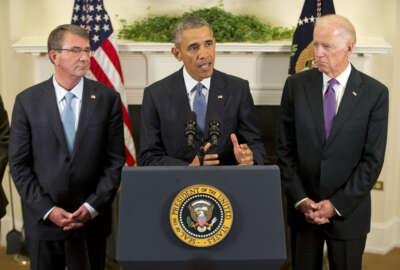
DoD focusing on threats, not modernization in budget
The Defense Department is ramping up its spending in Europe to counter Russian aggression, despite a $17 billion deficit in the fiscal 2017 budget.
Despite a $17 billion deficit in planned spending for fiscal 2017, the Defense Department will ramp up funding troops and exercises in Europe.
DoD Comptroller Mike McCord said Nov. 30 that the department will be putting more money in the European Reassurance Initiative (ERI).
The fund was created in 2014 to build a larger U.S. presence in Europe after Russia annexed the Crimea region of Ukraine. ERI received $1 billion in 2014 and about $750 million in 2015.
“What we are looking at is a more robust version of what we’ve been doing. Exercising, having more presence there and more troop rotations,” McCord said during a speech at the Center for Strategic and International Studies in Washington. “Not going back to the old days and having 300,000 people stationed there necessarily, but continuing the higher level of presence and exercising with our Eastern European allies.”
McCord added that the funding would also go into more permanent assets like bases and pre-positioning in Europe.
Deputy Defense Secretary Bob Work hinted earlier this month that ERI would be a big priority when he told reporters DoD had figured out the budgeting situation for its big programs, but was still figuring out funding for Europe.
The United States has been increasingly leery of Russia as it rattled its saber in the Ukraine and more recently in Syria.
Even more recently, Russia and Turkey have been on especially cold terms after Turkey shot down a Russian fighter jet on the border of Turkey and Syria. Turkey is a NATO country.
While more immediate threats are receiving more funding, McCord said modernization efforts will be taking the brunt of the cuts the department must make in 2017 to fit into the congressional budget agreement.
“There will probably be some slowdown in some modernization programs,” McCord said.
Contract protests have already slowed down the Long Range Strike Bomber, which will push off some spending for DoD.
The budget deal agreed to by Congress allows for funding of DoD at $610 billion for 2017. About $551 billion will be in the base budget and $59 billion in overseas contingency operations, an emergency war fund.
DoD originally planned to spend about $15 billion more than that. President Barack Obama’s decision to keep 5,500 troops in Afghanistan through 2017 added $2 billion or $3 billion to the price tag.
Congress already had to find ways to cut allowed spending for the 2016 budget. The Defense authorization bill originally approved $612 billion for DoD, but that had to be cut to $607 billion to satisfy the parameters of the budget deal.
A lot of those cuts came from extra funds Congress added to the bill.
Despite DoD not receiving exactly what it hoped for, McCord said the budget agreement was a “good deal” for the department and signaled a change from the previous brinksmanship of Congress.
The deal brings two years of budget certainty to the department and keeps DoD from having to further reduce its force structure.
While DoD can breathe a little easier on the budget, McCord said it is still working to become audit ready.
The military services submitted their audits this fall, but McCord said the audits are not going to come back clean.
“People have internalized [the audit] as a goal, but it’s just going to be difficult for us to get there given our size and our complexity and the need to get so many parts of the community … working together,” McCord said. “I think we are on the right track … it will take a couple more years … you can’t learn to swim on the beach you have to actually get into it. To really learn things you need to have independent auditors say this is what you’re doing right, this is what you’re not doing right.”
Copyright © 2025 Federal News Network. All rights reserved. This website is not intended for users located within the European Economic Area.
Scott Maucione is a defense reporter for Federal News Network and reports on human capital, workforce and the Defense Department at-large.
Follow @smaucioneWFED





